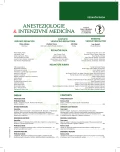Management of sepsis-induced disseminated intravascular coagulopathy using antithrombin and heparin, and the use of thromboelastometry in establishing the diagnosis of heparin resistance
Authors:
M. Durila 1; P. Salaj 2; H. Součková 3; M. Astraverkhava 1; J. Beroušek 1
Authors‘ workplace:
Klinika anesteziologie, resuscitace a intenzivní medicíny, 2. LF UK a FN Motol, Praha
1; Ústav hematologie a krevní tranfuze, Centrum pro trombózu a hemostázu, Praha
2; Gynekologicko-porodnická klinika, 2. LF UK a FN Motol, Praha
3
Published in:
Anest. intenziv. Med., 27, 2016, č. 6, s. 358-363
Category:
Intesive Care Medicine - Case Report
Overview
Severe sepsis is often accompanied by disseminated intravascular coagulation (DIC) and multiple organ dysfunction. Increased activation of coagulation is characteristic for this syndrome and therefore, from the pathophysiological point of view, it would be logical to intervene at the initiation of coagulation by the administration of antithrombin and heparin. Evidence from randomized studies offering clear instructions on the usage of these drugs is lacking though. In our case report we describe the management of septic DIC with antithrombin and heparin without bleeding complication. We have found that in order to stop the consumption of the coagulation blood components, it is required to maintain antithrombin levels above 90%. Because of the high risk of heparin resistance in sepsis it is appropriate to monitor the level of heparin with anti Xa with the aim of 0.5–0.6.
KEYWORDS:
antithrombin – heparin – heparin resistance – disseminated intravascular coagulation – thromboelastometry
Sources
1. Levi, M., Toh, C. H., Thachil, J., Watson, H. G. Guidelines for the diagnosis and management of disseminated intravascular coagulation. British Committee for Standards in Haematology. Br. J. Haematol., 2009, 145, p. 24–33.
2. Wada, H., Asakura, H., Okamoto, K. et al. Expert consensus for the treatment of disseminated intravascular coagulation in Japan. Thromb. Res., 2010, 125, p. 6–11.
3. Warren, B. L., Eid, A., Singer, P. et al. Caring for the critically ill patient. High-dose antithrombin III in severe sepsis: a randomized controlled trial. JAMA, 2001, 286, p. 1869–1878.
4. Kienast, J., Juers, M., Wiedermann, C. J. et al. Treatment effects of high-dose antithrombin without concomitant heparin in patients with severe sepsis with or without disseminated intravascular coagulation. J. Thromb. Haemost., 2006, 4, p. 90–97.
5. Durila, M., Teslík, L., Astraverkhava, M., Vymazal, T. Úloha tromboelastometrie a antitrombínu v manažmente počínajúcej diseminovanej intravaskulárnej koagulopatie po peripartálnej hysterektómii. Anest. Intenziv. Med., 2016, 27, 2, p. 75–77.
6. Pecka, M. Laboratorní monitorování antikoagulační léčby. Doporučení pro klinickou praxi. Vydáno 16.3.2006 u příležitosti konání XII. Pařízkových dní. Dostupné na www: http://www.thrombosis.cz/sources/Guidelines-Monitoring_antikoagulace_STH_III062.pdf
7. Hirsh, J., Raschke, R. Heparin and low-molecular-weight heparin: the Seventh ACCP Conference on Antithrombotic and Thrombolytic Therapy. Chest, 2004, 126, p. 188–203.
Labels
Anaesthesiology, Resuscitation and Inten Intensive Care MedicineArticle was published in
Anaesthesiology and Intensive Care Medicine

2016 Issue 6
Most read in this issue
- Depth of anaesthesia monitoring
- Thrombophilic conditions during pregnancy
- Regional anaesthesia and haemostasis-modifying drugs – latest recommendations
- Preventive immobilisation of the cervical spine in pre-hospital emergency care in trauma patients: update
